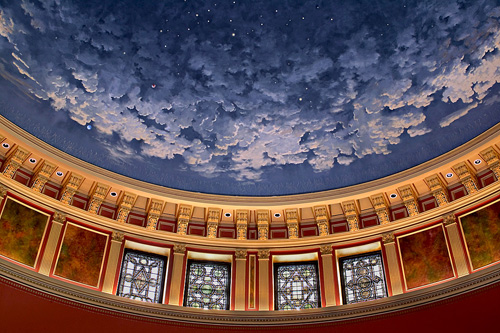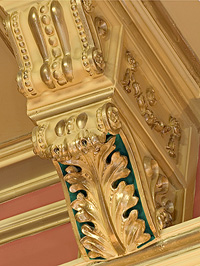
Thomas Moore Studios, Baltimore, Md.
Thomas Moore Studios, concentrating on painting scenic backgrounds for theatrical productions, movies and the advertising industry. Besides enjoying theatrical work, he credits it with helping him develop a successful business strategy.
by Loretta Hall
These words of 19th-century Irish poet Thomas Moore seem to fit modern-day Baltimore painter Thomas Moore. Since graduating from the Maryland Institute in 1974, Moore has devoted his professional life to various forms of artistic expression. After working as a photographer and illustrator, he settled into the art of painting.
Moore started his own business in 1988, concentrating on painting scenic backgrounds for theatrical productions, movies and the advertising industry. Besides enjoying theatrical work, he credits it with helping him develop a successful business strategy. “They’re never going to change opening night,” he says. “The people are going to come into the theater, so you’d better be done or you’re in deep trouble. That’s one thing we pride ourselves on here. We take deadlines seriously.”
During the next eight years, Moore’s company, Studio Backdrops Inc., grew steadily in volume and scope. Then a neighboring business moved out, and he doubled his studio space to more than 5,000 square feet. “We’ve seen around 20 to 30 percent growth for the past seven or eight years,” he says. “It’s been very exciting.”
The company slowly moved into what Moore calls more “permanent” work, projects such as murals, historical restorations and faux finishing. To reflect the new focus, he changed the company’s name to Thomas Moore Studios Inc. in 2002.
“What intrigues me about restoration is it’s an interesting mix of art history and science,” Moore says. “You have to have a sense of historical references and historical trends in painting and the materials that have been used over the years, as well as using your artistic training [to recreate damaged areas].”
The process often involves opening small exposure windows, meticulously stripping away layers of finishes to reveal the original paint, and performing a paint analysis to replicate the original color for an authentic restoration.
“And then there’s the scientific aspect of using historically appropriate materials but also finding modern equivalents that are longer-lasting,” Moore explains. “Instead of the bronze powders that they used historically, which tend to tarnish, there are mica-titanium powders that we can suspend in various solutions which are nontarnishing and visually are equally applicable.”
Another restoration technique Moore uses is plaster consolidation. “Often, you’ll have some plaster failure on a mural that’s painted right on the plaster,” he explains. “In the past, they would remove the plaster, plaster it up, and repaint it. With plaster consolidation, we inject acryloid resins, which rebond the plaster to the substrate. It keeps the amount of in-painting and repairs to the original artwork to a minimum.”
Although Moore and his nine employees do easel painting conservation, it’s the large restoration projects on historic buildings that attract the most attention. One example is their recent work on the Lovely Lane United Methodist Church, a Baltimore building designed by Stanford White and finished in 1887. Moore’s work included formulating a custom color, Stanford White Red, to accurately reproduce the predominant interior tone.
An even bigger challenge was restoring a 6,000-square-foot mural on the church’s domed ceiling. The original mural had been painted over in 1900 and then covered with painted canvas in 1930. Stripping those away revealed what was left of the initial work. “It had the heavens painted with the stars placed as they appeared at 3 o’clock in the morning, November 6, 1887, to commemorate the day the church was consecrated,” Moore says. “We figured out that they laid out a star map on the scaffolding and then projected it onto the ceiling with strings and plumb bobs.” Referring to the star charts the original muralists had used as well as modern versions obtained from NASA’s Goddard Space Flight Center, Moore was able to recreate the historic mural’s essence. “We weren’t making it a planetarium,” Moore says. “There was a lot of artistic interpretation involved there. We put the main stars where they were supposed to be, and then tried to make [the sky and clouds] more dramatic.” The result earned widespread acclaim, including a 2004 Building Congress & Exchange Craftsmanship Award.
Conversion of the old Maryland headquarters of the Standard Oil Co. to an upscale apartment building offered another showcase for Moore’s expertise. Constructed in the early 1920s, the building’s grand entrance gallery was lined with marble panels. Nearly one third of the panels were missing, and even if matching material could be obtained, the cost of replacing them would have been prohibitive. Painting a faux marble design on plaster panels and skillfully creating a polished surface that matched the surviving marble panels, Moore and his staff made replacements that are visually indistinguishable from the originals.
“We do a lot of historic restoration, but we also do new work,” Moore says. For example, last year, he painted an art deco mural for Fenway Park’s Pavilion Club in Boston.
 Also, some of his restoration projects involve creating new designs to complement historic elements. An excellent example is Moore’s recent work on Baltimore’s 1929 Bank of America building. Because of Depression-era financial constraints, the front lobby was never decorated to the same extent as other portions of the building. Moore and his team developed a design scheme that represented what might have been. Using a trompe l’oeil technique to make paintings appear to be stone carvings, they created a series of wall emblems depicting industry themes such as shipping, printing and law. Borrowing a design from an existing bronze floor medallion, they created a gilded mural of a tall ship. And for a stunning ceiling design that echoed a pattern and type of vibrant color used in the original decor, Moore developed a new proprietary paint color, Baxter Blue, and fashioned a richly glowing sunburst by applying a garnet glaze over copper and aluminum leafing. Also, some of his restoration projects involve creating new designs to complement historic elements. An excellent example is Moore’s recent work on Baltimore’s 1929 Bank of America building. Because of Depression-era financial constraints, the front lobby was never decorated to the same extent as other portions of the building. Moore and his team developed a design scheme that represented what might have been. Using a trompe l’oeil technique to make paintings appear to be stone carvings, they created a series of wall emblems depicting industry themes such as shipping, printing and law. Borrowing a design from an existing bronze floor medallion, they created a gilded mural of a tall ship. And for a stunning ceiling design that echoed a pattern and type of vibrant color used in the original decor, Moore developed a new proprietary paint color, Baxter Blue, and fashioned a richly glowing sunburst by applying a garnet glaze over copper and aluminum leafing.
Thomas Moore has devoted himself to growing a successful business that can fulfill the need to beautify our surroundings. Surely, his 19th Century namesake would have approved. After all, the Irish poet wrote, “We can’t begin to live a more artful life, which is the avenue to the soul, if in the public life around us, and everything we see and inhabit, art is invisible.”

|

